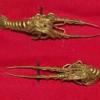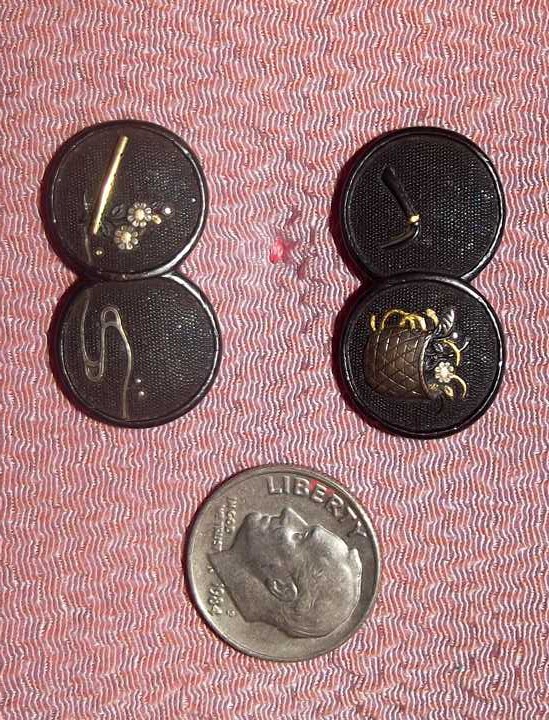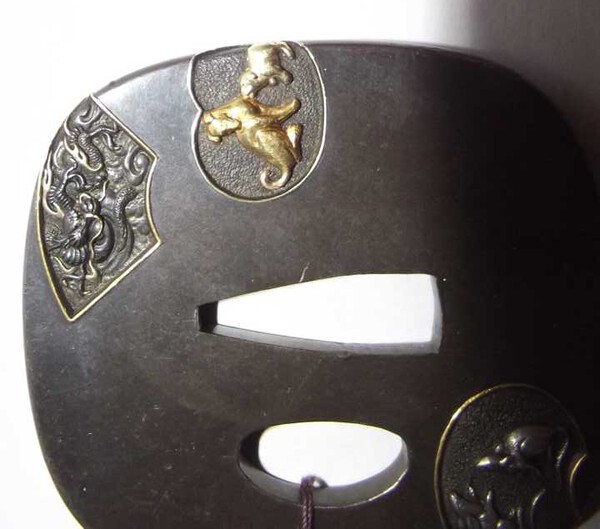-
Posts
435 -
Joined
-
Last visited
Content Type
Profiles
Forums
Events
Store
Downloads
Gallery
Everything posted by Lance
-
Maybe they were just like the markings fighter pilots used to put on their planes for kills.......... Regards, Lance
-
I'm aware that Mon were on almost everything, and was only using it as an example that I've read in Western books, Christies auction catalogs on fittings as well as in past JSSUS articles. I've never given it much thought one way or the other but it sounded plausible Also, I still think the Edo period rules for koshirae would be a good research point for those so inclined for something more concrete, I would assume some form of it still exist in writing and that there might be something dealing with what was allowable for different classes/ranks in it if such rules existed. This would actually be proof of a sort if it was written that way, the other alternative basically amounts to an unspoken rule on what was just etiquette or "socially acceptable" at the time and I thought it would be a little more constructive than arguing what the meaning of "is" is. Regards, Lance
-
I haven't seen it mentioned here but could the idea of rank on fittings be attributed to the "dress code" for koshirae during the Edo Period alternate attendance/residence edict for Daimyo? I believe the requirements were for a black lacquered saya, black wrap over white ray skin tsuka with shakudo tsuba and fuchi with horn kashira. Is it possible that the use of mon on these fittings fit with the idea of status: One example I've read numerous times and been told is that the more kiri mon on a fuchi or tsuba indicated a higher social level and might fit with or be interpreted as the western idea of different rank markings? Wether this is true or not or only apples to kiri mon I don't know, but it might be a good place to start and see what the actual rules were in full detail if they still exist in writing? It seems like everything before the Edo period would be more fluid, the class system was more volatile pre-Edo period due to families/individuals rising and falling in power or wiped out all together? Also when weapons were taken from dead enemies on the battlefield would samurai pass up on a sword above his station and give it to his superior or would it be part of his reward for courageous fighting? Regards, Lance
-
Those are Chidori or Japanese plovers: a small seabird popular in Japanese art Regards, Lance
-
Lovely tsuba, I'd guess the lack of information for artists like this is due to them working exclusively for a wealthy patron (Hosokawa Dainyo in this case) for their personal use and not to sell so the regular public/craftsmen community never saw much of it? Regards, Lance
-
Hello Ludolph, I don't see it belonging to the Kaga group who were originally sword smiths, described as producing iron plate tsuba, seems like they would probably resemble tosho or other Kaga style tsuba, with flush inlay, except for Kaga Goto I haven't seen many fittings that had people, mostly plants and insects, I thought that's what they were known for) To me it looks more like Nara/Hamano work, maybe with a little Soten mixed in, that's what pointed me more towards Mito as they were supposed to have been influenced/copied that style, below are a couple links to the Boston Museum of Mito and Kaga style work to at least illustrate my thoughts: http://www.mfa.org/search/collections?k ... aga+school http://www.mfa.org/search/collections?k ... mito+tsuba Regards, Lance
-
I wanted to post this tsuba and some of the research I've done to see what others might think and if they might have any images of fittings or info about Katsukuni: Iron tsuba with extensive carving and inlay; design of Yoshitsune at the battle of Dan-no-ura depicting his famous eight boat leap, escaping from Taira no Moritsune. After Moritsune realizied he'd never catch Yoshitsune, he commited suicide by grabbing a Minamoto warrior under each arm and jumping into the ocean, drowning himself and his two victims.. Reverse with mei and crashing waves with silver and shakudo dot inlay with carved rim. Tsuba measures 2 7/8 by 2 3/4 inches so in hand the detail is pretty amazing and very crisp (to me) Patina is darker/less brown than images Signed Katsukuni with kao on the back instead of the face of the tsuba, I've seen this referred to as being used on presentation tsuba as a gift? The only likely Katsukuni I found worked in Mito, Hitachi province. Famous for making copies of Toshinaga and Yokoya school fittings and producing a double form rim. Also forged signtures of a large scale on swords, was warned against it and as a "just punishment" went blind when he was middle aged. Died 1775 Most of the info about Mito Katsukuni I got from Hayne's index of Japanese sword fittings that I recently purchased (thanks Grey) and general reading about some Mito artists copying other schools. There's other examples listed in the index Sotheby's November 11, 1993 lot 73 and Naunton collection pages 189 and 258, I was hoping if anyone had these books they might post an image of them or images of any other fittings by Katsukuni? couple links to a Toshinaga tsuba depicting waves and another tsuba with Yoshitsune and Moritsune in almost the same poses but on a flat plate. http://educators.mfa.org/objects/detail ... a+Sanemasa http://www.emuseum.jp/detail/100516/000 ... os=1&num=8 http://www.flickr.com/photos/somewhatlucid/6041216756/ Thanks for reading, Lance
-

Dai Token Ichi 2012
Lance replied to Brian's topic in Sword Shows, Events, Community News and Legislation Issues
Thank you Mike, for the information and posting such great examples of fittings to enjoy. Regards, Lance -

Dai Token Ichi 2012
Lance replied to Brian's topic in Sword Shows, Events, Community News and Legislation Issues
Beautiful tsuba, if it's not too much trouble could you share any information about Miyamoto Musashi's sword? Besides reading stories of him using wooden swords/oars in famous duels, I'm not familiar with any of the swords he used, or if he had any preference for a specific smith/school. Thank you in advance for your time, Lance -
The only shin-gunto with aluminum blades I've ever seen in were basically modern unsharpened Iaito used as a tsunagi to hold a genuine set of mounts together, they were all listed by Japanese dealers possibly because non traditional Showa-to are Illegal to own but still more sword-like than a wooden blade, maybe it's one of these? Only aluminum parts I know of that were used on Showa era swords were aluminum saya for officer's swords and handles for NCO swords. I have come across western WW1- WW2 (European,American) aluminum swords and bayonets described as made for training but I don't know if Japan ever used them. Most old photos available that show any Japanese military training with swords looked to be traditional kendo(?) equipment Regards, Lance
-
Hello Jacques, What should I be looking at? The only thing I see after copying and zooming in on the picture in photo editing software is a worn ken horimono on a blade that looks to hira zukuri on that side? (I do agree with not planning on a polish, especially considering the photo quality isn't really a basis to evaluate such an investment on) Regards, Lance
-
From the pictures it looks like it might hira zukuri (flat on both sides) or kata kiriha zukuri ? (Flat on one side with ridge following along the cutting edge) 1st pic, there appears to be glare off one of the lines cut in a horimono of a ken instead of a shinogi. 2nd pic, the light makes that side look like the shinogi follows along the edge? http://meiboku.info/guide/form/zukuri/index.htm I don't see any ridge in the nakago, so I'd guess the shape was one of the two mentioned above, any sword that has a shinogi usually follows all the way through the to the end of the tang, probably need clearer pictures. Regards, Lance
-
I agree, great pictures! I remember going to the Arts of the Samurai exhibit at the Met and thinking how good the lighting was for viewing the blades. The tapered shape of the nakago on the Hizen Munetsugu is a "trademark" of sorts for the first and second generation, looks like a beautiful sword. Regards, Lance
-
Thank you Chris, I've seen "button type" menuki but they usually had a mon or maybe a coiled dragon, haven't seen such small nanako before, whovever did it must have had good eyes and a steady hand. Regards, Lance
-
Figured I'd revive this thread for a second to share a set of menuki I picked up from the same person as the other fittings. Same fine detail, they don't have a gold rim like the others but the rest looks close enough to make me suspect that at least the fuchi-kashira and menuki were originally part of a set (not sure about tsuba). Shot with a dime for scale, gold flute actually has carvings for holes and what looks to be silver applied for bright edge on kama/nata blade. Regards, Lance
-

a choice to ponder nagamitsu or star stamped blade
Lance replied to zentsuji2's topic in General Nihonto Related Discussion
I think your original interpretation was correct, there were 3 swords in all, he bought the Nagamitsu that was in original polish and mounts over the polished Nagamitsu. The third sword offered wasn't by Nagamitsu and had a star stamp, rougher shape with some chips to the edge. Regards, Lance -
I'll say maybe 2 and 7 (koa-isshin? or I'm wrong and one or both are Yasukuni) and definitely number 9 (Seki). Should be fun even if incorrect.. Due to the limited pictures it might be more fair to say "X" out of 11 pics is a Showato? Regards, Lance
-
Not a big deal but the Helmet on the cover of the catalog is listed as being a Kappa, (water spirit) but it looks more like a Tengu. Below are some links to compare; an example from an earlier Christie's auction, I think it was also in Ian Bottomley's book Arms and Armor of the Samurai? http://www.bonhams.com/auctions/20503/l ... 0%26m1%3D1 http://www.christies.com/lotfinder/lot/ ... 04095&sid= Regards, Lance
-
They aren't that uncommon, I've seen plenty of old blades (Koto up to Shinshinto) in samurai nounts including the original saya conerted for use by an officer, they'd just put a leather cover over the saya. A suspension ring was usually added under the cover, the kurikata was either removed or had a hole cut out for it. I think the Fuller and Gregory books have a few examples of civillian/samurai swords being used this way. Quality varies, the one posted below is a nicer than usual example of what you might come across. viewtopic.php?f=50&t=9312 Regards, Lance
-
Hello David, I did get them from the same person but I don't believe they were ever part of a koshirae together, (or at least I hope not as I'd hate to think of a good period koshirae being broken up for parts.) The change in patina around the opening for nakago is a little larger and different shape than the fuchi I posted, they do seem similar enough that they could have been from the same group though? Regards, Lance
-
Thank you Jim, I really should pick up the Hayne's index and other books on fittings. Most references I have for fittings are old auction catalogs, (Haynes auctions catalogs, Compton, etc.) Best Regards, Lance
-
Below are a tanto/wakizashi tsuba and fuchi kashira I've been trying to find out more about: all done in shibuichi with gold rimmed fan panels with zodiac animals on front and back in different soft metals, with very fine detail. For the translation on tsuba I was able to come up with Yuhoken(?) Masahiro with Kao below. Was hoping/wondering if anyone was familiar with this artist? Added a few pictures included some with a dime for scale to show level of detail, fuchi- kashira (kashira is upside down in pics, sorry) that I'd think might be the same school, similar gold rimmed fans, but with super tiny shakudo nanako in panels; birds, flowers and a stream,tsuba is actually same color as fuchi kashira, but they were the best I could do to catch details, both look to be from the 1800's. Also as a side question did Japanese artists ever create or import any types of magnifying glass for their work? Thanks in advance fore your time, Lance
-
The Samurai: A Military History by Stephen Turnbull is a good start, excellent overview of the many important leaders and warfare campaigns that took place over the centuries. Link to Amazon has a brief preview, you might be able to find it elsewhere as well. http://www.amazon.com/Samurai-Military- ... y+turnbull Regards, Lance
-
I think he was encouraging you to try and translate it, as it will be more rewarding, and you'll learn more by trying it yourself. At the top of the link he gave you there's a table for different types of kanji; where it says kuni you can get the province, (first two characters) http://www.jssus.org/nkp/kanji_for_provinces.html next 2 characters can be found under common kanji, http://www.jssus.org/nkp/common_kanji.html and the last 2 you can look under nihonto kanji (kanji for mei) http://www.jssus.org/nkp/kanji_for_mei.html just compare the characters on your sword to the ones illustrated to find a match, and post your results to see if you're right or need more help. Lance .
















